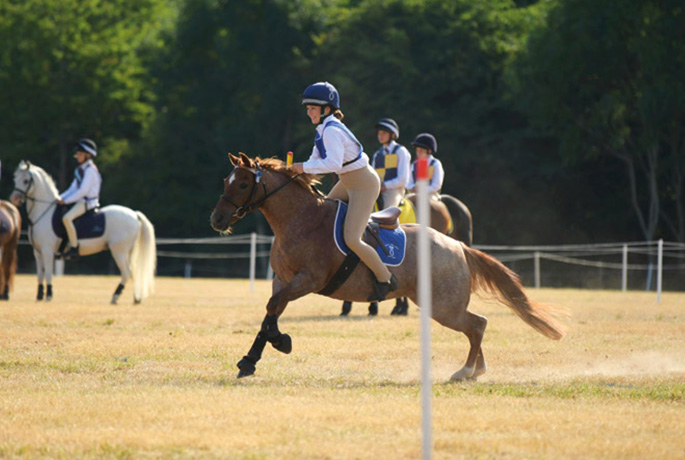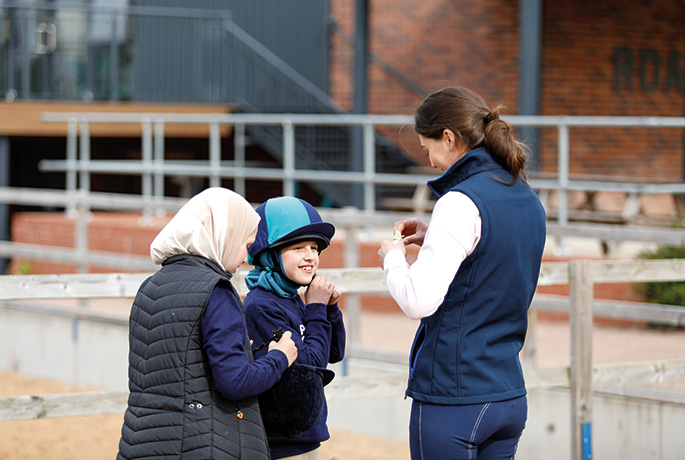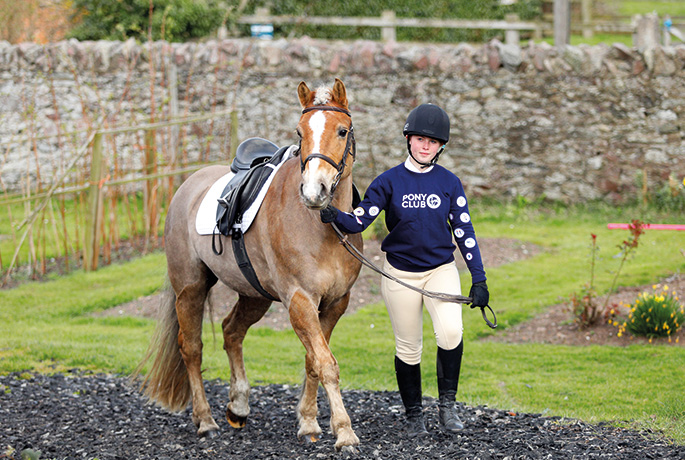Spurs
It is important that spurs are only worn by riders who have a stable lower leg and who are able to use
– or not use – the spur intentionally.
NEW for 2025 anyone needing to wear spurs must have passed their C+ Test or Spurs Test – more information regarding the spurs test coming soon…
Minimum expected requirements that should be discussed by the rider and coach
• If wearing spurs, the rider must:
▪ Have still hands and a seat that is sufficiently independent that they can maintain a quiet,
stable, still leg position.
▪ Understand that spurs are a refinement of a leg aid
▪ Be able to use their seat, hand, and leg aids individually
▪ Be mindful of the impact spurs may have on the horse/pony they are riding
• If wearing spurs, the spurs must:
▪ Be a maximum of 1.5 cm long or, if fitted with a ball at the end, a maximum of 4 cm long;
this length is measured from the back of the boot to the end of the shank
▪ Be fitted correctly, with the shank pointing slightly downwards
▪ Only be used as an additional aid, to back up and refine the leg aids
▪ Never be used to punish the horse
• If the pony/horse needs a strong bit for control, spurs are unlikely to be an appropriate aid
Misuse of spurs is defined as:
• Spurs used aggressively
• Spurs used to bully the horse/pony
• The rider kicking with the spurs as opposed to using them as a refinement of an aid
• Evidence of spur-induced rubs or injuries.
. A rider misusing spurs or unable to meet the minimum expected requirements will be required to
remove their spurs and should only resume wearing spurs when they have demonstrated to an
accredited Pony Club coach that they can meet the minimum expected requirements and/or that they
understand that the misuse of spurs is never acceptable.
Body Protectors 2024
A body protector is compulsory for all Pony Club Cross Country riding (including Arena Eventing)
and Pony Racing activities whether it be training or competition. A body protector for these
activities must meet BETA 2018 Level 3 Standard (blue and black label).
For general use, the responsibility for choosing body protectors and the decision as to their use must
rest with Members and their parents. It is recommended that a rider’s body protector should not be
more than 2% of their body weight. When worn, body protectors must fit correctly, be comfortable
and must not restrict movement. BETA recommends body protectors are replaced at least every
three to five years, after which the impact absorption properties of the foam may have
started to decline.
Air Jackets
If a rider chooses to wear an air jacket in Cross country or Pony Racing, it must only be used in
addition with a normal body protector which meets BETA 2018 Level 3 standard (blue and black
label). Parents and Members must be aware that riders may be permitted to continue after a fall in
both competitions and training rides for Cross Country and / or Pony Racing if the First Aid provider
has no concerns about their welfare. In the event of a fall, an air jacket must be fully deflated or
removed before continuing, the conventional body protector must continue to be worn. Air jackets
must not be worn under a jacket. Number bibs should be fitted over the air jacket loosely or with
elasticised fastenings.
Hats
Hat Rule 2024
Members must always wear a protective hat when mounted. Only hats to the following specifications are
acceptable at any Pony Club activity. The Pony Club is consistent with fellow British Equestrian (BEF)
Member bodies in its Standards for Riding Hats. Individual sports may have additional requirements with
regard to colour and type. It is strongly recommended that secondhand hats are not purchased.
The hat standards accepted as of 1st January 2024 are:
Hat Standard Safety Mark
Snell E2016 & 2021 with the official Snell label and number
PAS 015: 2011 with BSI Kitemark or Inspec IC Mark
(BS) EN 1384:2023 with BSI Kitemark or Inspec IC Mark
VG1 with BSI Kitemark or Inspec IC Mark
ASTM-F1163 2015 & 2023 with the SEI mark
AS/NZS 3838, 2006 with SAI Global Mark
Note: Some hats are dual-badged with different standards. If a hat contains at least one compliant hat standard it is deemed suitable to competition, even if it is additionally labelled with an older standard.
• For cross-country riding (at all levels) including Eventing, Arena Eventing, Tetrathlon and Hunter Trials,
together with Pony Racing (whether it be tests, rallies, competition or training) and Mounted Games
competitions, a jockey skull cap must be worn with no fixed peak, peak type extensions or noticeable
protuberances above the eyes or to the front, and should have an even round or elliptical shape with a
smooth or slightly abrasive surface, having no peak or peak type extensions. Noticeable protuberances
above the eyes or to the front not greater than 5mm, smooth and rounded in nature are permitted. A
removable hat cover with a light flexible peak may be used if required.
• No recording device is permitted (e.g. hat cameras) as they may have a negative effect on the performance
of the hat in the event of a fall.
• The fit of the hat and the adjustment of the harness are as crucial as the quality. Members are advised to try
several makes to find the best fit. The hat should not move on the head when the head is tipped forward.
The Pony Club recommends you visit a qualified BETA (British Equestrian Trade Association) fitter.
The Pony Club, Safety & Welfare
November 2023
• Hats must be replaced after a severe impact as subsequent protection will be significantly reduced. Hats
deteriorate with age and should be replaced after three to five years depending upon the amount of use.
• Hats must be worn at all times (including at prize-giving) when mounted with a chinstrap fastened and
adjusted so as to prevent movement of the hat in the event of a fall.
• For Show Jumping: hat covers, if applicable, shall be dark blue, black or brown only. Branch/Centre team
colours are permitted for team competitions.
• For Dressage: hats and hat covers must be predominately black, navy blue or a conservative dark colour
that matches the rider’s jacket for Area competitions or above. The Pony Club Hat silk is also acceptable.
• For Mounted Games: hat covers, if applicable, shall be dark blue, black or brown only.
• The Official Steward / Organiser may, at their discretion, eliminate a competitor riding in the area of the
competition without a hat or with the chinstrap unfastened or with a hat that does not comply with these
standards.
Hat Checks and Tagging
The Pony Club and its Branches and Centres will appoint Officials, who are familiar with The Pony Club hat
rule, to carry out hat checks and tag each hat that complies with the requirements set out in the hat rule with an Pony Club hat tag. Hats fitted with a Pony Club, British Eventing (BE) or British Riding Club (BRC) hat tag will
not need to be checked on subsequent occasions. However, the Pony Club reserves the right to randomly spot
check any hat regardless of whether it is already tagged.
Tagging is an external verification of the internal label and indicates that a hat meets the accepted
standards. The tag does NOT imply any check of the fit and condition of the hat has been undertaken.
It is considered to be the responsibility of the Member’s parent(s) / guardian(s) to ensure that their hat complies with the required standards and is tagged before they go to any Pony Club event. Also, they are responsible for ensuring that the manufacturer’s guidelines with regard to fit and replacement are followed.
For further information on hat standards, testing and fitting, please refer to the British Equestrian Trade
Association (BETA) website: British Equestrian Trade Association – Safety and your head (beta-uk.org)
The Pony Club Equine Influenza VACCINATION RULE 2024
To protect the health of all horses and ponies and the biosecurity of the venue, the following
rules will apply to all Pony Club activities. Members competing with other organisations,
such as FEI, BHA and HPA, or at certain venues, for example racecourses, will need to
comply with their vaccination requirements.
1. Passports
A valid passport (registered on the Central Equine Database) and vaccination record:
• must accompany the horse / pony to all activities
• must be available for inspection by the event officials
• must be produced on request at any other time during the activity
2. Equine Influenza Vaccination Schedule:
No horse / pony may attend an activity, compete or be present as a companion unless it has
a Record of Vaccination against equine influenza completed by the veterinary surgeon who
gave the vaccination, signed and stamped line by line, which complies with the Minimum
Vaccination Requirements set out in the Equine Influenza Vaccination Schedule below.
All horses and ponies receiving a new primary course of vaccinations from 1 January 2024
must be vaccinated according to this schedule:
• initial primary course of two vaccinations (V1 and V2) must be given: the second
vaccination (V2) must be administered within 21-60 days of the first initial vaccination
(V1)
• Horses may attend activities 7 full days after receiving the second vaccination of the
primary course (V2).
• A first booster vaccination (V3) must be administered within 120 – 180 days of the
administration of the second vaccination of the primary course.
• Thereafter booster vaccinations must be administered at a maximum of 12 months
intervals.
Horses and ponies must not attend activities within 7 days of receiving any vaccination. For
clarity: no horse or pony may compete on the same day as a relevant injection is given or on
any of the 6 days following such an injection.
NB: This is the minimally appropriate booster schedule; it is highly recommended that
horses and ponies competing regularly and travelling around the UK and abroad follow an
optimal schedule and receive a booster within 6 months +21 days prior to arrival at the
event or activity, in line with the FEI protocol.
Restart
Any horse which is found to have breached the requirements above in relation to V1 (initial
vaccination); V2 (second vaccination) and V3 (first booster), or exceeded 12 months between
subsequent boosters, must restart and receive a minimum of V1 & V2 and had a 7 day postvaccine stand-down before being allowed entry to any Pony Club activity.



